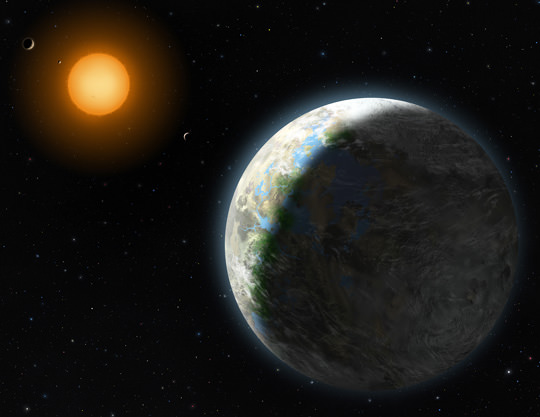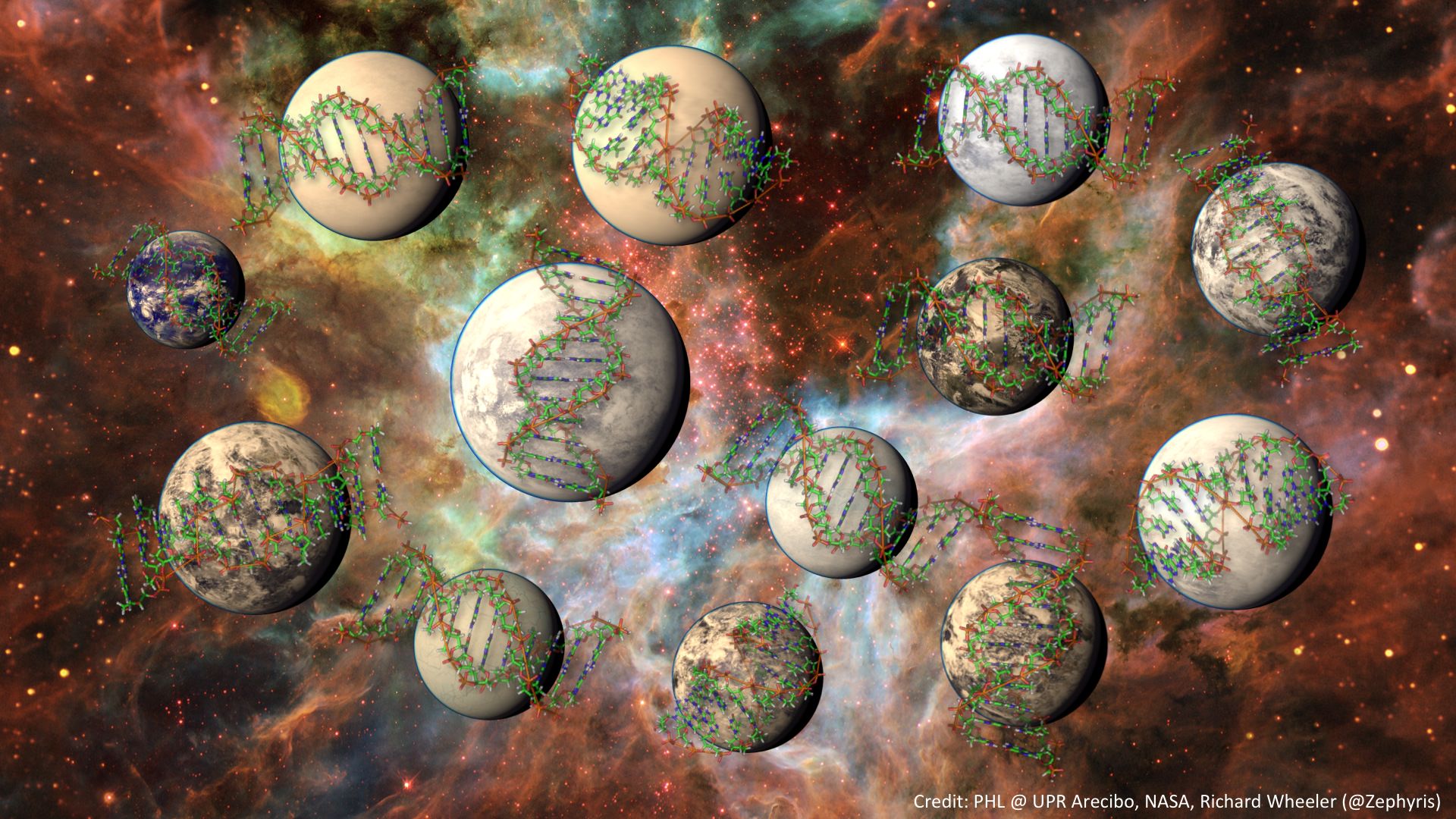What a multitude of worlds! A new study suggests that the Milky Way could host 100 million planets with complex life, leaving no lack of choice for astronomers to look for organisms beyond Earth. The challenge is, however, that these worlds might be too far away from us to do much yet.
“On the one hand, it seems highly unlikely that we are alone,” stated Louis Irwin, lead author of the study and professor emeritus at the University of Texas at El Paso. “On the other hand, we are likely so far away from life at our level of complexity, that a meeting with such alien forms is extremely improbable for the foreseeable future.”
The figure came from studying a list of more than 1,000 exoplanets for metrics such as their density, temperature, chemistry, age and distance from the parent star. From this, Irwin’s team formulated a “biological complexity index” that ranges between 0 and 1.0. The index is rated on “the number and degree of characteristics assumed to be important for supporting multiple forms of multicellular life,” the research team stated.
Assuming that Europa (a moon of Jupiter believed to have an ocean below its ice) is a good candiate for life, the team estimated that 1% to 2% of exoplanets would have a BCI that is even higher than that. So to translate that into some estimates: 10 billion stars in the Milky Way, averaging one planet a star, which brings us to 100 million planets minimum.

So what does this metric mean? There’s of course no guarantee that complex life exists in any of these places — just that the conditions could be conducive to life. Also, the researchers added, don’t assume that any life in this category would be intelligent life, but more life that is more complex than a microbe. And the known planets with higher BCIs tend to be pretty far away from us. (One of the closest is the Gliese 581 system, which is 20 light-years away.)
Read more about the research in the journal Challenges. Recall that a few years ago, this group also wrote about an “Earth Similarity Index” rating exoplanets on how close they are to our own.
“Planets with the highest BCI values tend to be larger, warmer, and older than Earth,” added Irwin, “so any search for complex or intelligent life that is restricted just to Earth-like planets, or to life as we know it on Earth, will probably be too restrictive.”
Source: Planetary Habitability Laboratory at the University of Puerto Rico at Arecibo


The awareness that we are not alone will be an interesting time.
Scientists that will love it.
Nutjobs that will channel these aliens.
Religious that will worship these gods.
Religious that will reject the discover and claim that it is a setup by Satanists.
Most people won’t care.
The biggest advantage of the search for others is new and more sensitive technology that could be very useful for people on Earth. Remote detection of chemicals, more sensitive detectors, more intelligent software that can search for patterns.
“Most people won’t care.”…. I must say I highly doubt this to be even close to accurate. The rest… well yes. 😉
I am just wondering.
Can Twin planets exist that rotate around each other while orbiting their sun?
I mean Earth Size.
Earth-Moon
Pluto-Charon
Not far from it anyway.
“Not far from it anyway”.
^^^^^^^^^^^^^^^
Both merely lacking (per ‘official’ definition, anyway) an internalized barycenter. 🙂
*I just read snowfist’s post. I hadn’t realized the E/M bary WAS internalized! This is a binary planet system! Earth and Luna. NEAT!*
Don’t think we have found a specific examples of this with exoplanets yet. But if their masses were very similar, they would orbit a point somewhere between them (barycenter). The closest analogs to this in our solar system are Pluto/Charon followed by the Earth/Moon system. Note that two hypothetical planets of the same size would also likely be tidally locked to each other (always show the same face like the Moon does from Earth).
Earth/Moon orbital point from Wikipedia:
Considering the Earth–Moon system as a binary planet, its centre of gravity is within the Earth, about 4,624 km from its centre or 72.6% of its radius. This centre of gravity remains in-line towards the Moon as the Earth completes its diurnal rotation. It is this mutual centre of gravity that defines the path of the Earth–Moon system in solar orbit. Consequently the Earth’s centre veers inside and outside the orbital path during each synodic month as the Moon moves in the opposite direction.
Pluto/Charon orbital point is outside of either body and is called the barycenter. Only known pairing in the solar system that does this.
Tidal locking doesn’t necessarily mean “showing the same face to the star” (or mother planet) if the planet has an eccentric orbit. Mercury is an example. And here’s a SETI talk about insolation on exoplanets:
http://www.seti.org/weeky-lecture/patterns-sunlight-extra-solar-planets
Olaf,
Twin Planets are perfectly reasonable and not too unlikely, given the right concatenation of circumstances. It’s unlikely that planets form as binary twins during their initial formation (though it has been argued by Tom Van Flandern in the past) but high-speed collisions and/or capture events could produce them.
What do you mean with: “So to translate that into some estimates: 10 billion stars in the Milky Way”? The estimations about number of stars in the Milky Way that I’ve heard of, are more or less around 100 billion to 400 billion stars. With the logic in this article, it would mean at least 1 billion planets in the galaxy with complex life.
And further, “And the known planets with higher BCIs tend to be pretty far away from us. (One of the closest is the Gliese 581 system, which is 20 light-years away.)”. In my opinion, 20 lightyears is very close, keeping in mind that the diameter of Milky Way is at least 100 000 light years! And the Gliese 581 is only one the closest systems found BY FAR.
100 million habitable planets, I wonder what Frank Drake thinks about these new data? 100 million planets seems awfully large until one compares that with the estimated number of stars in our galaxy.. which lays somewhere around 400 billion. This estimate indicates that possibly 1 in 4,000 stars has the potential for life. Still… given the size of our huge galaxy, this does NOT mean that any of these presumably inhabited stars are close by.
Consider this. Our sciences say that nothing can travel faster than the speed of light and even then, IF one were to approach a high percentage of that speed it might still take thousands or tens of thousands of years to cross the void for a visit.
So either we will need to physically step outside of this ‘space-time’ to travel to the stars or somehow otherwise violate the ‘laws of nature’ to do so. It seems more and more likely that the only way we will be able to explore our galaxy would be to do that WITHOUT a physical body. What’s that mean? We would have to evolve into something more like what we envison ‘angels’ to look like? to do a tour? What say? Do you want to leave your body behind and roam the galaxy for an eternity?
What if you were to meet one who has chosen to do that?
” IF one were to approach a high percentage of that speed it might still take thousands or tens of thousands of years to cross the void for a visit.”
Only if you pick destinations that are thousands or tens of thousands of light years away. There’s likely plenty of interesting stuff just within a *100* light year radius…
“It seems more and more likely that the only way we will be able to explore our galaxy would be to do that WITHOUT a physical body. What’s that mean? We would have to evolve into something more like what we envison ‘angels’ to look like?”
Speed of light limitations apply to matter, energy and information. Even ‘angels’ have to consist one or more of those…
All this talk about habitable planets is out of control. This means sure we could live there – fine. But the chances of life developing, ha! Its incredibly hard for life to develop even in ideal conditions. So there are 4×10 to the 11th stars in the galaxy – some estimates put the chances of life developing at 1 in 10 to the 113th. We have found 1000 good candidates?? Come on lets get real here .(http://evolutionwiki.org/wiki/The_odds_of_life_forming_are_incredibly_small)
You cite a source, and the source it sites is The Watchtower Bible? You’re going to have to do better than that. The fact is that there is no data whatsoever on how likely it is for life to begin. It could very easily be inevitable, given the right chemicals and temperatures and time. Finding a planet we could live on in quite a lot less likely than finding one with intelligent life. If the chemical mix isn’t exactly right, a planet could be poisonous to us even while supporting advanced intelligent life. (And if they came here, Earth would be poisonous to them.) It’s fine to comment on things you clearly know nothing about, but those comments should come in the form of questions or insightful observations, not condescending attitudes based on citations to unscientific works.
“On the one hand, it seems highly unlikely that we are alone,” stated Louis Irwin, lead author of the study and professor emeritus at the University of Texas at El Paso. “On the other hand, we are likely so far away from life at our level of complexity, that a meeting with such alien forms is extremely improbable for the foreseeable future.”
Sigh….on one hand, it’s wonderful that mainstream science has finally come around to the idea that other life exists in our galaxy. Yet at the same time, most scientists of note are still too worried to commit to more than that, so they always make sure to include the above caveat.
Baby steps, I guess.